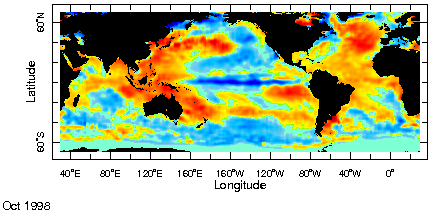
| ||||
IRI Climate Information Digest - October 1998Issued 13 November 1998, Next Issue 13 December
Highlights Mature La Niña conditions materialize. The tropical equatorial Pacific continued to experience development of the La Niña with colder than average sea surface temperatures from the South American coast to the Solomon Islands. Atmospheric La Niña conditions have also started to emerge in the rainfall patterns. Heavier than average rainfall has been observed in the far western Pacific including much of Indonesia and Australia with relatively dry conditions in portions of southeastern South America and the southeastern United States. Warmer than average sea surface temperatures prevailed south of the equator in eastern Pacific. However, these warm temperature anomalies were not large enough to provide an effective link with the atmospheric circulation and related temperature and rainfall patterns. October Atlantic TROPICAL STORM Activity Researchers have linked increased Atlantic Tropical Storm activity to La Niña conditions. The traditional end of the hurricane season saw two Atlantic hurricanes, Lisa and Mitch bringing the seasonal total to thirteen named storms. Hurricane Lisa was a minimal short-lived storm but hurricane Mitch was marked by its duration, strength and persistent destructive rains over Central America. [http://www.nhc.noaa.gov] Global rainfall patterns Consistent with the developing La Niña, dry conditions were experienced along the southeastern regions of the United States as well as in parts of southern Brazil, Uruguay, and Northern Argentina. Heavy rainfall, not directly related to the La Niña, was recorded over southeastern Europe from Switzerland southeastward through Romania and into Turkey. Heavy rainfall typhoon-related rainfall occurred in the Philippines, South Korea and Taiwan. In Japan, typhoon rains added to a generally wet seasonal pattern. Global Temperatures Averaged global temperatures continued above the 1961 to 1990 average for through October. The unbroken sequence of well above average monthly global temperatures during the year virtually insures that 1998 will be a record warm year. Northern Hemisphere regions from Mongolia eastward through China, Korea, and Japan as well as northern Africa through the Arabian Peninsula were particularly warm. Southern Hemisphere temperatures were well above average northwestern Argentina eastward through Uruguay and southern Brazil. Forecasts - Seasonal Temperature and PrecipitationImpacts - On Fisheries, Agriculture, Health and Hazards.
|

